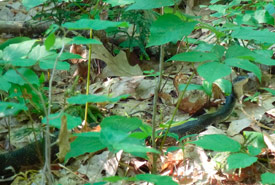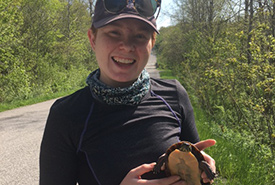Hope, the gray ratsnake

Hope, the gray ratsnake (Photo by NCC)
This summer, I had the opportunity to go out with Nature Conservancy of Canada (NCC) field staff and reptile biologists from partner organizations to track a gray ratsnake dotingly named Hope, to which we'd previously attached a radio tracking device.
But prior to tracking down Hope, we set out on a survey of NCC properties for suitable ratsnake habitat. This survey was part of a partnership between Ontario Nature and Natural Resource Solutions Inc. (NRSI) to study the species’ habitat and to gauge its population size and distribution.
Currently the Carolinian population of gray ratsnake is listed provincially and federal as endangered by the Committee on the Status of Endangered Wildlife in Canada. The biggest threats to this species are habitat destruction, destruction of hibernacula (a fancy term for where snakes sleep in the winter), mistreatment from humans and road mortality.
Ratsnakes have particular habitat needs that can require management. They love variety, needing woodland mixed with open habitat, such as fields and rock outcrops. With this mix, they can find dead trees, still standing or fallen, to lay their eggs in, and rock crevices for shelter and hibernation during the winter months.
As a conservation technician, I assisted the crew in defining habitat through ecological land classification practices, or, in other words, naming all the plants you can find. My favourite! We also monitored specific spots in the forest to check how much cover the trees provide. Tree cover is important to ratsnakes, and there needs to be enough of it. With these tree cover calculations, biologists can run exciting simulators to see if the forest is currently a happy home for a species, or will be in the future. After surveying vegetation, we scoured the area for snakes, but after having no luck, not even sighting a common eastern gartersnake, we set out to radio track Hope.
This was my first time assisting on a radio tracking excursion, and it was quite exhilarating to search for a species I had yet to come across in the wild. We set out for Hope’s last known location, and pulled out the antenna and receiver to track her location. The receiver was set for a high monitoring range to cast a large net to see if Hope was in the area. We listened to the beeps — a louder beep meant she was close, like a game of hot-and-cold, but with volume.
As we exhausted the larger areas, we slowly decreased the range to pinpoint her exact location. Steadily listening to the beep, we waved the antennae up and down and side to side to see if she was up a tree or on the forest floor. With the signal on the lowest setting, our crew moved in very slowly and deliberately — she could be underfoot! Just as we were honing in, we saw her head pop up from the undergrowth of the forest floor. What a sight! From a distance, we took notes on her size and the habitat she was found in. Once the notes were done, we watched as she slowly slithered back into the underbrush.
It’s opportunities like this that have fostered my love for the environment and for conservation, and drive me to pursue a future in wildlife conservation management.
Through land securement and partnerships, NCC continues to research and manage habitat. With the help of the community, we can learn to admire these creatures, and others, as they are an integral part of our ecosystem, and we can continue to help their population flourish. You can do your part to help sustain snake populations by reporting any sightings to Ontario Nature.


